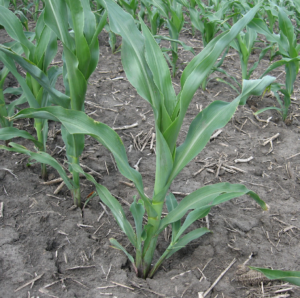Tillers are vegetative or reproductive shoots that grow from the base of grass plants. Corn tillers are a normal physiological process like those in small grains. Although tillers can be perceived to be less desirable in corn, the overall effect of tillers is usually neutral. Tillers may have some benefit if corn is produced for silage because more dry matter can be produced.
What Are Tillers?
Tillering is common in grass plants, and corn is a highly specialized grass plant. Tillers are branches that develop from buds on the lower five to seven nodes of a corn plant (Figure 1).1 Tillers are genetically identical to the main stem and can develop their own roots, nodes, leaves, tassels, and ears if there is sufficient time in the season. While tillers are an essential part of wheat, barley, and oat production, they are perceived to be far less desirable in corn. They are commonly referred to as “suckers” on corn because of a misconception that they “suck” the nutrients from the main stem. However, research has shown that this is not the case, and that the overall effect of tillers on corn is usually neutral.

Figure 1. Corn tillers. If the tillers do not produce an ear, the photosynthates they produce during grain fill can be remobilized to the ear on the main stalk.
Why Do Tillers Develop?
The number of tillers that develop is a function of plant population, spacing, soil fertility, early season growing conditions, and the genetic background of the product.(2) Tillers are more likely to be found on plants that are in thin areas of the stand or nearfield edges. Ample supplies of soil fertility and moisture favor tiller development. Some seed products are more genetically prone to tiller. Research has shown that there is very little movement of photosynthate between the main stem and tillers before tasseling.2 However, after silking and during grain fill, plant sugars may move from earless tillers to ears on the main stem. When there are ears on both the tiller and the main stem, very little movement of plant sugars occurs. The main stem and tillers act independently, and each receives sugars from its own leaves.
What Can Be Done?
If there are no problems with stand establishment, diseases such as crazy top or Stewart’s wilt or there has been injury to the apical growing point on the main stalk, tillers are no cause for concern regarding yield potential.1,2 If a particular corn product shows excellent yield potential and produces some tillers under normal growing conditions, it is not a cause for concern. However, excessive tillering (more than two or three tillers per plant) may indicate problems with stand density and distribution.2 Less than optimal plant populations or row gaps are conditions that should be corrected for next year to help obtain optimal yield potential.
